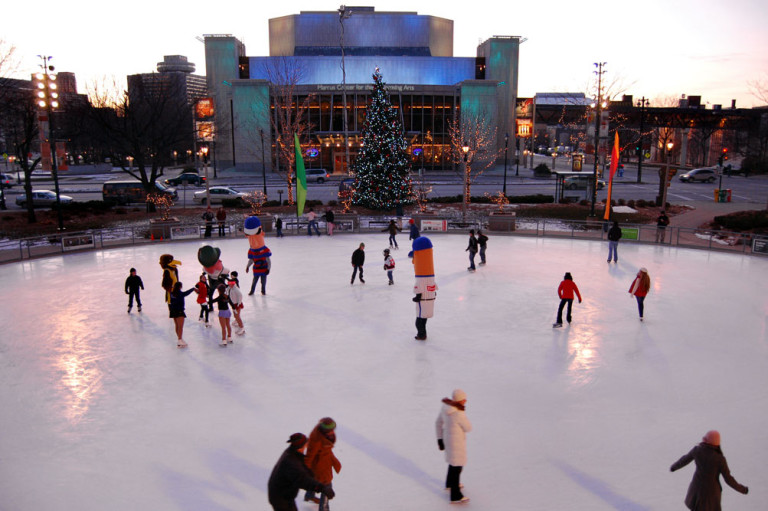Preventing Winter Injuries – Winter Safety in Wisconsin

Winter Injury Prevention
Most of us are pretty used to the cold and snowy winters in Wisconsin. However, winter recreational activities and chores can pose problems for the outdoor enthusiast whose body is not in condition. Winter sports like skating, skiing and sledding can cause painful muscle spasms, strains or tears if you’re not in shape. Even shoveling snow the wrong way, clambering awkwardly over snow banks, slipping on sidewalks and wearing the wrong kinds of clothing can all pose potential for spasms, strains and sprains. Just like the reminder to drive more slowly in the first big snow fall, here are a few winter injury prevention tips to help get you through the snow and cold!
Skiing, Skating or Sledding
The American Chiropractic Association (ACA) suggests that you start with some light aerobic activity for about 7-10 minutes before participating intensely in these activities. Follow these tips to help you ensure you’re properly warmed up before activities:
Skiing – do 10 to 15 squats. Stand with your legs shoulder width apart, knees aligned over your feet. Slowly lower your buttocks as you bend your knees over your feet. Stand up straight again.
Skating – do several lunges. Take a moderately advanced step with one foot. Let your back knee come down to the floor while keeping your shoulders in position over your hips. Repeat the process with your other foot.
Sledding/tobogganing – do knee-to-chest stretches to fight compression injuries caused by repetitive bouncing over the snow. Either sitting or lying on your back, pull your knees to your chest and hold for up to 30 seconds.
Don’t forget cool-down stretching for all of these sports!
Shoveling
 With the first big snow storm of the year upon us, this is a timely reminder. Snow is a lot of fun for children to play in, but can be a lot of work for adults who have to shovel! Shoveling should be thought of as a workout, especially if you’re not used to regular exercise. As mentioned above, a proper warm up is critical to avoiding injury.
With the first big snow storm of the year upon us, this is a timely reminder. Snow is a lot of fun for children to play in, but can be a lot of work for adults who have to shovel! Shoveling should be thought of as a workout, especially if you’re not used to regular exercise. As mentioned above, a proper warm up is critical to avoiding injury.
The ACA suggests the following tips for exercise of the snow shoveling variety:
- If you must shovel snow, be careful. Listen to weather forecasts so you can rise early and have time to shovel before work.
- Layer clothing to keep your muscles warm and flexible.
- Shoveling can strain “de-conditioned” muscles between your shoulders, in your upper back, lower back, buttocks and legs. So, do some warm-up stretching before you grab that shovel.
- When you do shovel, push the snow straight ahead. Don’t try to throw it, instead walk it to the snow bank. Avoid sudden twisting and turning motions.
- Bend your knees to lift when shoveling. Let the muscles of your legs and arms do the work, not your back.
- Take frequent rest breaks to take the strain off your muscles. A fatigued body asks for injury.
- Stop if you feel chest pain, get really tired, or have shortness of breath. You may need immediate professional help.
Vitamin D
Your production of vitamin D is greatly reduced during winter months due to the short daylight hours and limited skin exposure when outside. Your body essentially stops producing vitamin D and relies on stored supplies of vitamin D from the summer months. Low vitamin D levels can cause several symptoms including fatigue, lots of aches and pains, and even feeling sad and/or depressed. If you are experiencing any of these symptoms, it may be a sign that you need to increase your vitamin D intake. Before increasing your vitamin D intake, you should make sure you talk to your primary care doctor.
Cold Exposure
 The cold can affect your body temperature very quickly, so remember to wear multiple layers when you go outside. Simply walking outside in the freezing weather without layers of warm clothing can intensify older joint problems and cause a great deal of pain. As muscles and blood vessels contract to conserve the body’s heat, the blood supply to extremities is reduced. This lowers the functional capacity of many muscles, particularly among the physically unfit. So remember to dress in layers (you can always take unneeded layers off) and take breaks to go inside and warm up!
The cold can affect your body temperature very quickly, so remember to wear multiple layers when you go outside. Simply walking outside in the freezing weather without layers of warm clothing can intensify older joint problems and cause a great deal of pain. As muscles and blood vessels contract to conserve the body’s heat, the blood supply to extremities is reduced. This lowers the functional capacity of many muscles, particularly among the physically unfit. So remember to dress in layers (you can always take unneeded layers off) and take breaks to go inside and warm up!
Stay Healthy and Warm!
If you experience back pain or muscle soreness after any winter activities, it may be beneficial to see a chiropractor. At Elite Sport & Spine, we utilize many different treatments to keep you moving and functioning at your best. In addition to chiropractic manipulation, we have extra training in many different techniques, including soft tissue mobilization, myofascial release, and corrective exercises. If you have any questions or would like to schedule an appointment, feel free to call us at 262-373-9168. Stay healthy and stay warm!
For more winter injury prevention and safety tips, you can go to the ACA website.
 262-373-9168
262-373-9168




